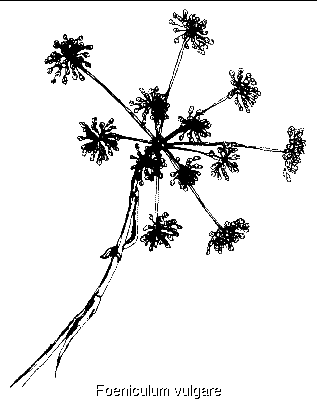FENNEL
(Foeniculum vulgare)

Appearance
An erect perennial or biannual up to two metres high with
smooth stems, feathery leaves and small yellow flowers in numerous
heads. The sub-species vulgare has sweet tasting fruit while the
more common sub-species piperitum has acrid tasting fruit.
Habitat
The sub-species vulgare flowers between April and September and
grows in fields and gardens from sea-level to 5,600 ft, perhaps always as
an escape from cultivation. The sub-species piperitum flowers from June
to October and grows on sandy shores, sand dunes, in dry stony fields, on
hillsides, and in dry riverbeds from sea-level to 4,000 ft.
Uses and Properties
The whole plant and especially the seeds are rich in
"olio foeniculi", which consists mainly of anethin which imparts an
aniseed-like flavour to the plant. The leaves are used to flavour fish
sauces, cutting through the oilyness of fish and fresh cut in soups or
with beans. The ancient Greek name for the plant means to grow thin and
fennel has long been attributed with slimming properties. Its' diuretic
action and appetite suppressing properties may explain this. Fennel
stimulates breast milk production as it contains galactogogues. It is also
used as gripe water for babies. The Romans used fennel to reduce
flatulence while Pliny considered it good for the eyesight and an
antidote for snake bites. In modern medicine it is used as a digestive
tonic, reducing flatulence. It is also used in eye washes and as a
diuretic.




